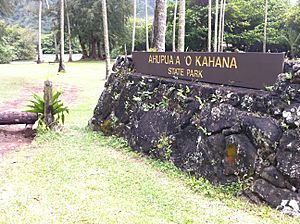Ahupuaʻa O Kahana State Park facts for kids
Quick facts for kids Ahupuaʻa O Kahana State Park |
|
|---|---|

Entrance to Kahana Valley
|
|
| Type | State park |
| Location | Oʻahu |
| Nearest city | Kahana Bay |
| Designation | State park |
Ahupuaʻa O Kahana State Park is a special place in Oʻahu, Hawaii. It used to be called Kahana Valley State Park. This park is on the windy side of Oʻahu, between the towns of Kaʻaʻawa and Punaluʻu. It stretches from the ocean all the way up to a mountain peak called Puʻu Pauao, which is 2,670 feet high.
This park is unique because it's Hawaii's only public ahupuaʻa. An ahupuaʻa is a traditional Hawaiian land division that goes from the mountains to the sea. This means it includes different environments, from forests to the coast. The park has a tropical climate and gets a lot of rain, sometimes almost 300 inches a year! Its main goal is to share and teach about Hawaiian culture.
Contents
History of Kahana Valley
Long ago, before people from other parts of the world came to Hawaii, Kahana Valley was a busy place. The community had plenty of fresh water and seafood. They also grew a lot of taro, a plant used for food, in special fields with smart watering systems.
However, around the 1800s, when King Kamehameha united Hawaii, things changed. Many people in the valley got sick from new diseases. Also, the land was used to grow sugarcane. During World War II, the valley became a training center for soldiers learning jungle warfare.
Later, in the early 1900s, much of the valley belonged to Mary E. Foster. After she passed away, the land went to Bishop Estate. The state of Hawaii wanted to buy the ahupuaʻa to make it a park. It took some time, but the state eventually bought the land. This is how it became a state park. Today, about 31 families still live in the valley.
Animals of Kahana Park
Kahana State Park is home to many different birds and fish. In the streams of the lower valley, you might find a native freshwater fish called Oʻopu naniha (Stenogobius hawaiiensis). The Huilua Fishpond has ʻAmaʻama (flathead mullet) and milkfish.
Many bird species live here too. In the lower valley, you can see birds like the Pacific golden plover, ruddy turnstone, and wandering tattler. There are also native Hawaiian waterbirds like the ʻaukuʻu (black-crowned night heron), ʻalae keʻokeʻo (Hawaiian coot), and ʻalae ʻula (Hawaiian gallinule). The Hawaiian coot and gallinule are endangered, meaning they are at risk of disappearing forever.
Higher up in the valley, you can find native Hawaiian songbirds like the ʻapapane and Oʻahu ʻamakihi. There are also birds that are not native to Hawaii, such as mynahs, cardinals, doves, and ricebirds.
Some pigs, called feral pigs, were brought to the valley by the first Polynesian settlers. While the valley is a good place for them to live, these pigs can cause problems for the other plants and animals in the park.
Plants of Kahana Valley
The land in Kahana Valley stretches from the sea to the mountains. This means it has many different areas where various plants grow. Near the coast, you can find koa trees (Acacia koa), hibiscus, and hala trees (Pandanus tectorius). There are also open grassy areas.
Further up the valley, where it's wetter, you'll see different plants. These include mountain apple trees (Syzygium malaccense), strawberry guava (Psidium littorale), ti plants (Cordyline fruticosa), and bamboo.
Things to Do in Kahana Park
Hiking Trails
If you like to hike, Kahana Valley has two trails that are great for families. You don't need a special pass for these.
- Kapa'ele'ele Ko'a and Keaniani Lookout Trail: This trail is one mile long and goes in a loop. It takes most hikers about an hour to complete.
- Nakoa Trail: This trail is 2.5 miles long and goes through a tropical rainforest. It's named Nakoa because of the many koa trees (Acacia koa) you'll see. On this trail, you can even swim in the Kahana stream, which you cross twice!
Camping and Hunting
- Camping: There are ten campsites right on the beach. You need a special permit to camp here.
- Hunting: Hunting is allowed in certain areas on weekends and holidays. You also need a permit for hunting.

